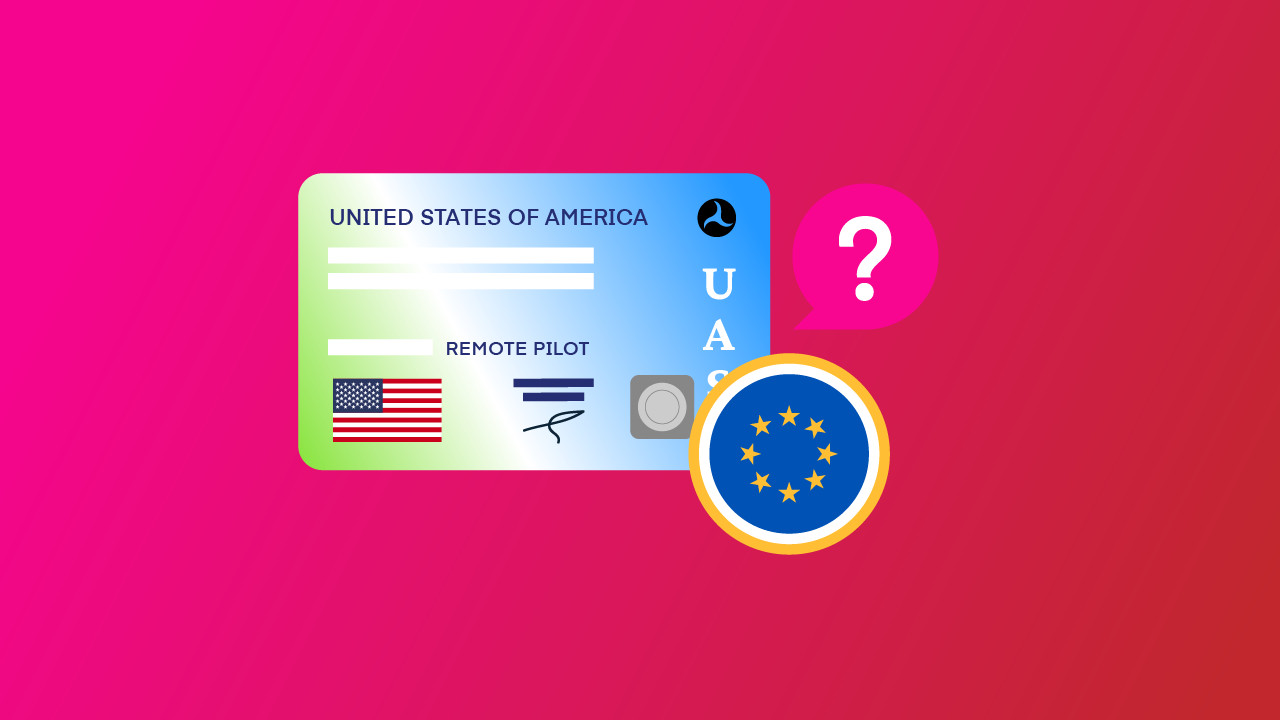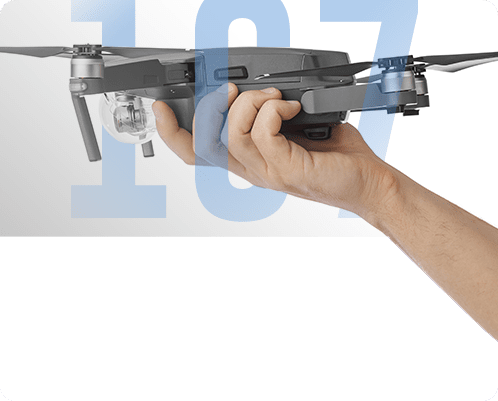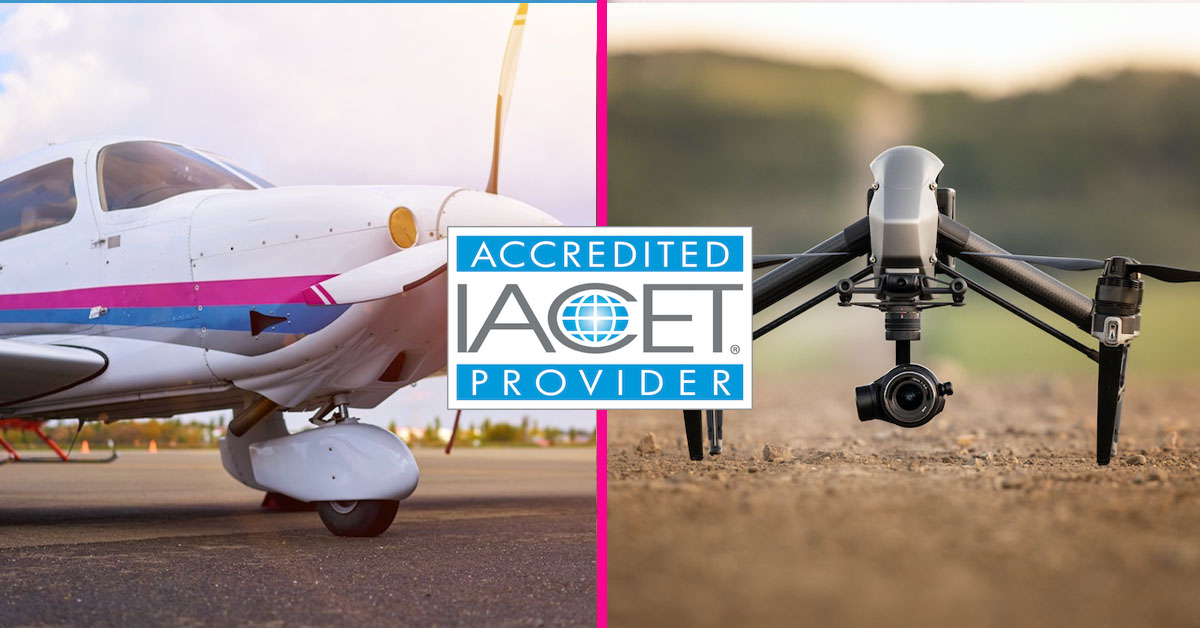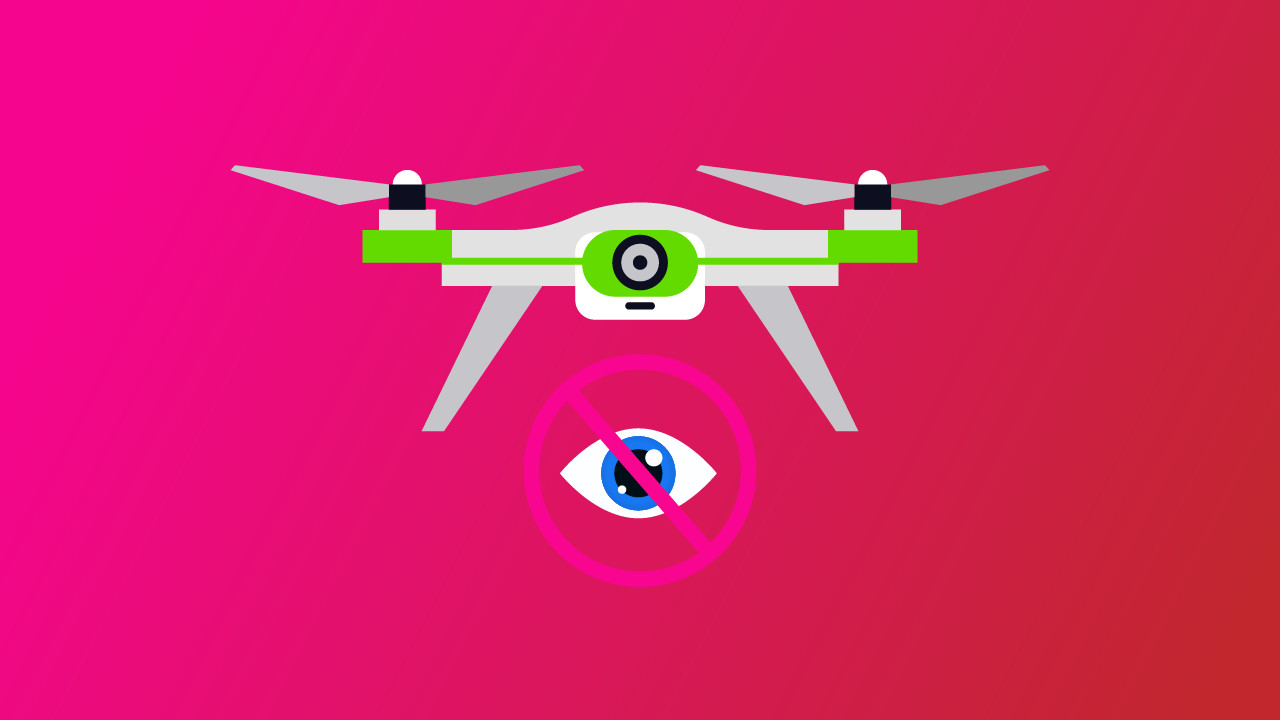-
Key Takeaways
-
1. Why a Part 107 Certificate Matters
- Why Citizenship Myths Persist
-
2. FAA Eligibility: Part 107
- TSA Security Threat Assessment (STA)
- Acceptable Identity Documents
-
3. Step-by-Step: Earning Part 107 as a Foreign Pilot
- Create an FTN (FAA Tracking Number)
- Book & Take the Knowledge Test
- Study Resources
- File Form 8710-13
- Keep Current
-
4. Extra Regulatory Layers for Foreign-Registered Drones
- U.S. Registration & Recognition of Ownership
- Remote ID & Notice of Identification
- DOT Economic Authority (14 CFR Part 375)
-
5. Choosing Your Path: Three Visitor Scenarios
- Tourist Filming for Fun
- Freelancer on a Short Contract
- Relocating Professional
-
6. Misconceptions & Pitfalls
-
7. Practical Travel & Field Tips
- Crossing Borders with Batteries
- Must-Carry Documents
- De-Escalation Script
-
8. Mini Case Study: UK Architect Wins U.S. Contract
-
Conclusion
Have you ever wondered if you’re able to use a drone in a foreign country? What laws and regulations would you have to follow? What waivers would you need printed and signed? The list of questions begins to unravel, and it can quickly become an overwhelming task.
For many tourists, visitors, and business partners of the U.S., the answers to these questions can be vague and confusing. This guide will walk you through the different myths, procedures, and rules you should be aware of before trying to get a Part 107 license in the United States.
Drone tourism, global freelance work, and international contracts are all growing fast in the drone industry. This guide explains exactly what the FAA requires of non-US citizens, how TSA vetting works, and what extra permits may apply if you bring in a drone from a different country.
Key Takeaways
- You do not need to be a US citizen to obtain a Part 107 drone license.
- TSA background checks are automatic after you apply through the Integrated Airman Certification and Rating Application (IACRA) website.
- Foreign passports are valid IDs for testing centers.
- Some operations require extra permits, such as Part 375.
1. Why a Part 107 Certificate Matters
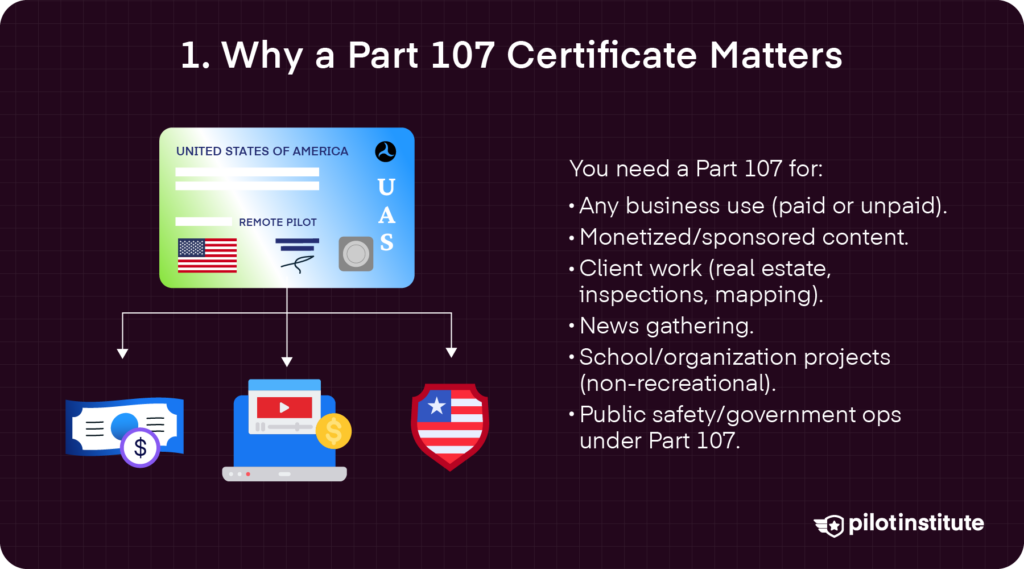
Part 107 is required whenever drones are used for commercial purposes. That includes monetized YouTube videos, nonprofit promotion, or freelance aerial photography.
Even if you’re doing an operation entirely for free, if a party can still benefit from your photos or videos, you must have a Part 107-licensed RPIC.
Why Citizenship Myths Persist
So why do myths about citizenship in aviation continue? People often confuse manned aviation employment rules with drone regulations.
In manned aviation, U.S. airlines may require pilots to be citizens or permanent residents for security and hiring purposes, but the FAA does not require citizenship to earn an Airline Transport Pilot (ATP) certificate.
2. FAA Eligibility: Part 107
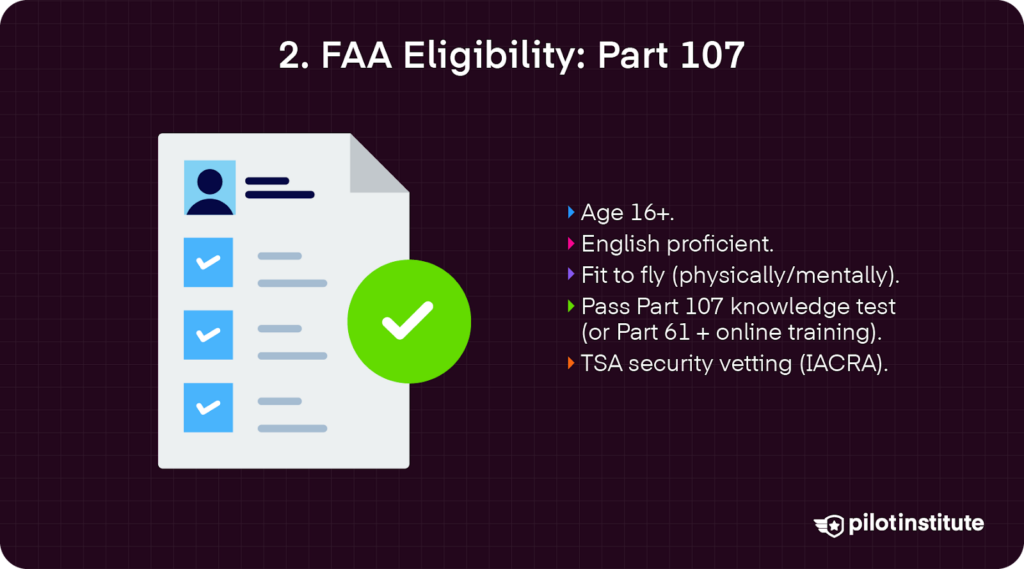
To qualify for a Part 107 certificate, you must:
- Be at least 16 years old
- Understand English
- Be physically and mentally able to fly safely
- Pass the aeronautical knowledge exam
TSA Security Threat Assessment (STA)
When you sign up through IACRA, every application is checked by TSA. Most results will return in two to ten days, but it could take longer.
Flags can include unresolved visa overstays or database matches.
Acceptable Identity Documents
Non-U.S. citizens must present a valid, current passport AND a second acceptable form of ID, such as a driver’s permit or license issued by any U.S. state or territory, or an identification card issued by any government entity (for example, a military or government-issued ID).
Both documents must include a photo, date of birth, signature, and physical residential address.
For full guidance, you can check the FAA Airman Knowledge Testing Matrix, which details all acceptable document types and testing procedures.
3. Step-by-Step: Earning Part 107 as a Foreign Pilot
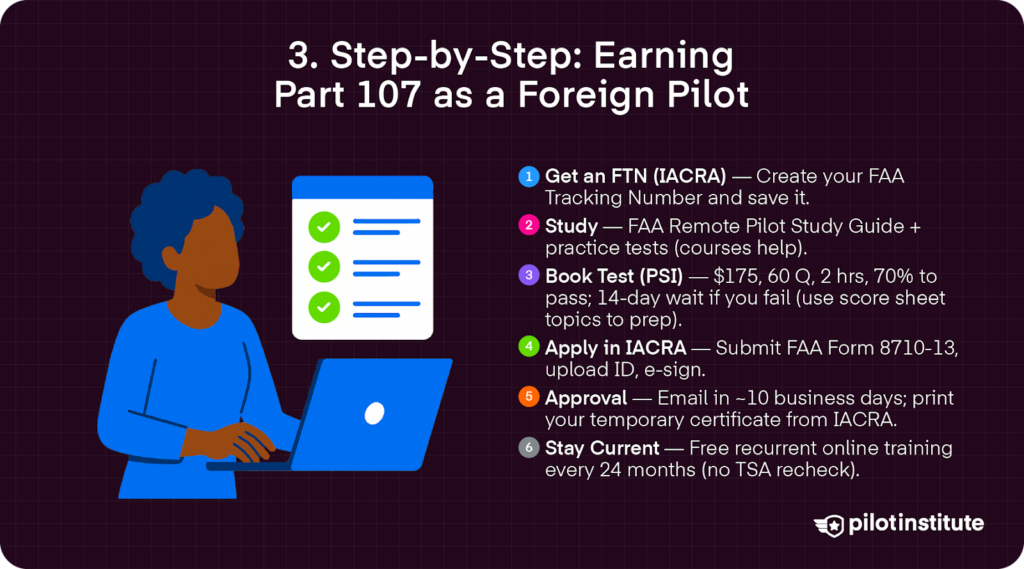
Create an FTN (FAA Tracking Number)
You will need to register for a free FTN, or FAA Tracking Number, on a website called IACRA. This number links the test results and your certificate.
Be sure to keep a record of this FTN for future use.
Book & Take the Knowledge Test
Schedule your test through PSI Exams. The exam costs $175, has 60 questions, lasts up to two hours, and requires a 70% or higher to pass. If you fail, you must wait 14 days before retaking the test.
If you fail and want to know what you missed so you’re better prepared for a second attempt, reference the sheet you’re provided after the test that has the corresponding topics.
Study Resources
Use the free FAA Remote Pilot Study Guide and practice exams. Most pilots also choose structured courses for higher pass rates. Pilot Institute’s Part 107 Made Easy course is a great resource for people seeking certificates.
File Form 8710-13
After passing the test, log in to IACRA again and submit FAA form 8710-13. Upload your ID, sign electronically, and (most importantly) await approval.
An email notification is sent within roughly 10 business days with instructions for printing the temporary certificate from the IACRA website.
Keep Current
Every 24 months, take the free recurrent online training. No TSA recheck is required for the training.
4. Extra Regulatory Layers for Foreign-Registered Drones
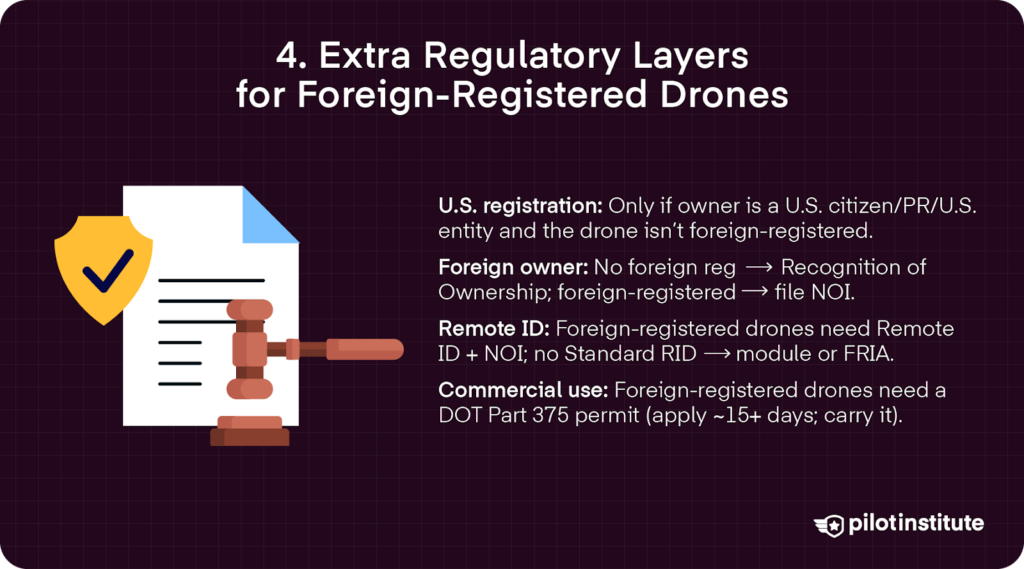
U.S. Registration & Recognition of Ownership
A small UAS can be registered in the U.S. only if it has not been previously registered in another country and the owner meets FAA eligibility (U.S. citizen, permanent resident, or U.S.-based entity).
The process is different for foreign nationals: if the drone is not registered abroad, the FAA issues a Recognition of Ownership. But if the drone is already registered in another country, the operator must instead file a Notice of Identification (NOI) with the FAA
Remote ID & Notice of Identification
Foreign-registered drones must comply with Remote ID regulations as well. Before flying in the U.S., operators must file a Notice of Identification (NOI) in FAADroneZone.
An NOI is required for recreational and Part 107 flight with an RID-equipped drone.
If the drone lacks Standard Remote ID, a broadcast module must be attached or the drone must be flown only in FRIA zones.
DOT Economic Authority (14 CFR Part 375)
Commercial operations with foreign-registered drones require DOT approval under Part 375.
Permits take about 15 days, typically last 2 years, and must be carried during flights.
5. Choosing Your Path: Three Visitor Scenarios
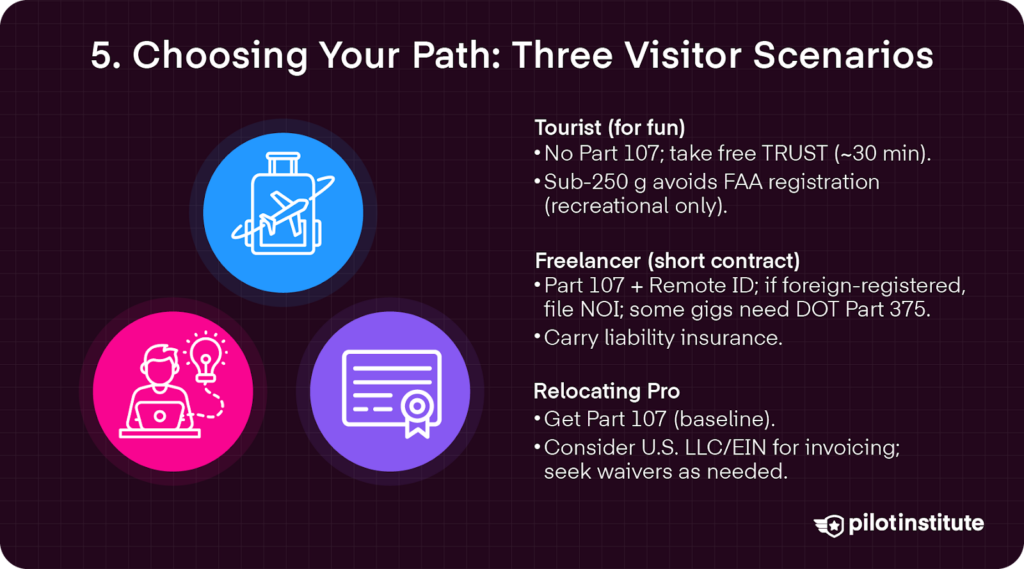
Tourist Filming for Fun
Visitors who only want to capture vacation footage do not need a Part 107 certificate. Recreational flyers instead take the free TRUST exam, which is available online and takes about 30 minutes.
A sub-250 g drone is ideal because it avoids the FAA registration step when flown exclusively for recreational purposes.
Freelancer on a Short Contract
A short-term job, such as aerial photography or mapping, requires more paperwork.
You’ll need a Part 107 certificate, a Notice of Identification, and Remote ID Compliance. You may also be required to obtain a foreign aircraft permit, but it’s always best to check.
Liability insurance is also recommended; some U.S. clients will not accept work without it.
Relocating Professional
Those moving to the U.S. for work should treat Part 107 as a baseline credential. Many employers require it, and it can serve as the foundation for future waivers.
Setting up a U.S. LLC or obtaining an EIN can also help with client invoicing and taxes.
6. Misconceptions & Pitfalls
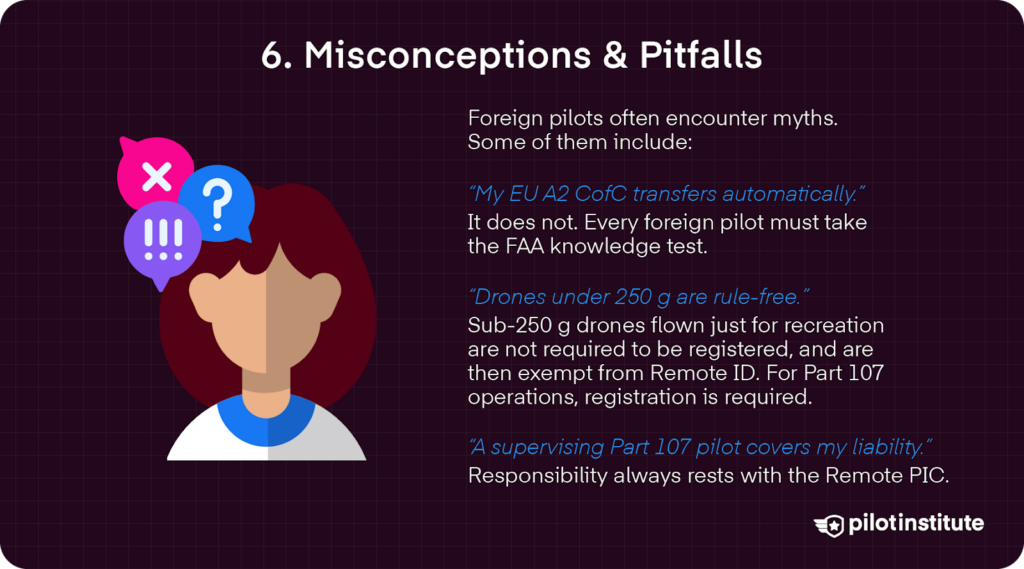
Foreign pilots often encounter myths. Some of them include:
- “My EU A2 CofC transfers automatically.”
It does not. Every foreign pilot must take the FAA knowledge test. - “Drones under 250 g are rule-free.”
Sub-250 g drones flown just for recreation are not required to be registered, and are then exempt from Remote ID. For Part 107 operations, registration is required. - “A supervising Part 107 pilot covers my liability.”
Responsibility always rests with the Remote PIC.
Flying a drone commercially without a Part 107 certificate is illegal and can result in civil penalties of up to $32,666 per violation and, in more serious cases, as high as $75,000 per violation.
7. Practical Travel & Field Tips
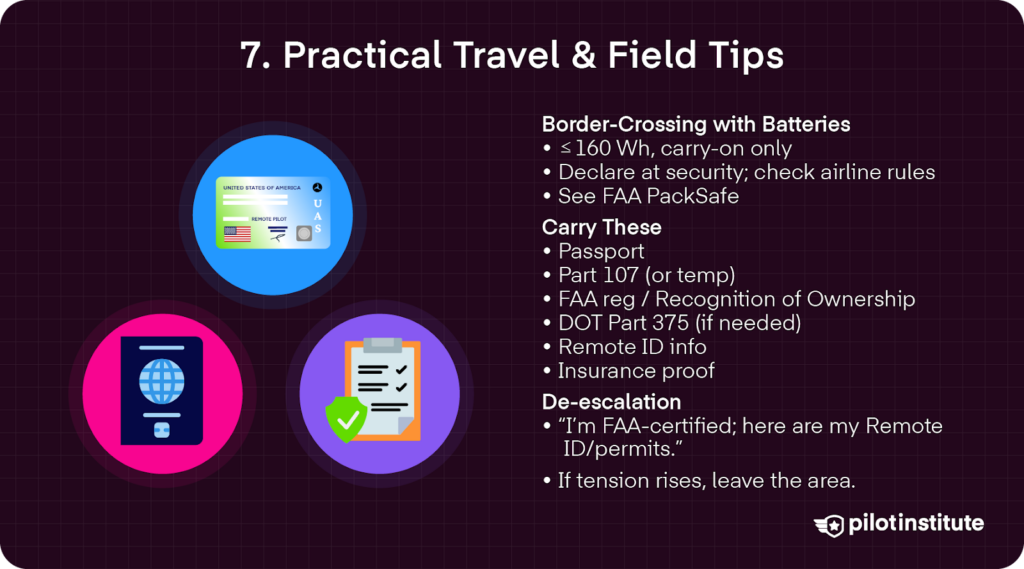
Crossing Borders with Batteries
IATA has a 160 Wh limit; carry-on only; declare at TSA; link to FAA SafePack instructions.
IATA has a 160 Wh limit, and that’s carry-on only. Certain airlines may have their own rules or restrictions, so be sure to check those as well. If you need more information on battery handling, packing, or transport, refer to the FAA’s PackSafe guide.
Must-Carry Documents
The documents you always have to carry are as follows:
- Passport.
- Part 107 certificate (or temporary cert).
- FAA registration or recognition of ownership.
- Part 375 permit if required.
- Remote ID compliance sheet.
- Proof of insurance.
De-Escalation Script
If approached by police or property owners, stay calm. Example: “I’m FAA-certified. Here is my remote ID broadcast, and I can show my permits.” If the other party continues escalating the situation, remove yourself.
8. Mini Case Study: UK Architect Wins U.S. Contract
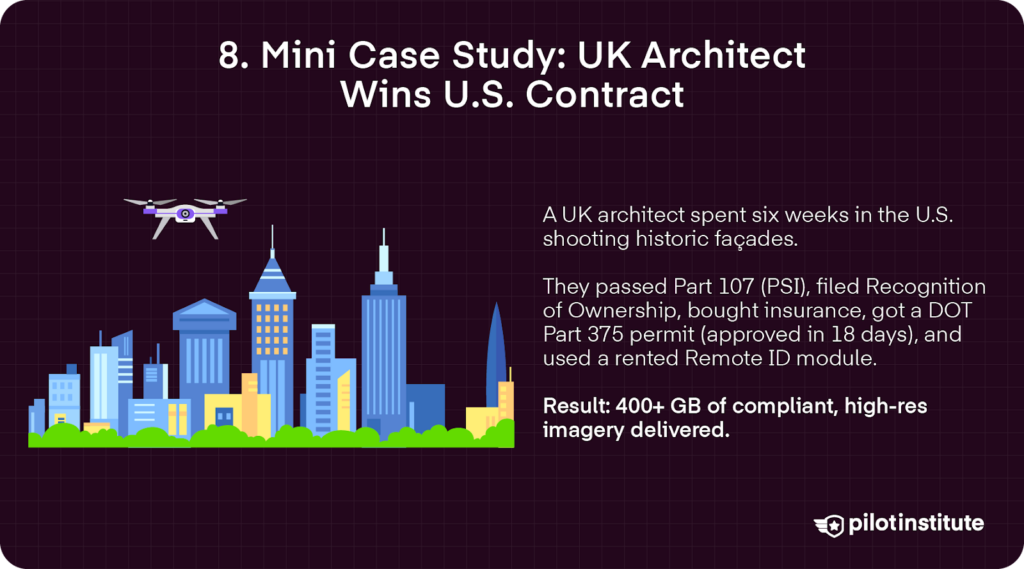
In this hypothetical scenario, a UK-based architect was hired for a six-week project in the United States to capture detailed images of historic building façades.
Preparation began before travel: the FAA Part 107 exam was scheduled and passed at a PSI testing center ($175 fee). The drone was registered under FAA recognition of ownership ($5), and liability insurance was purchased (~$175).
Because the drone was foreign-registered, a DOT Part 375 foreign aircraft permit was also required. Approval took 18 days, and the permit must be carried during all flights/operations.
The biggest challenge came from the Remote ID rules. Because local retailers were out of stock, the team rented a Remote ID broadcast module from a U.S. drone supplier to stay compliant.
By the end of the project, the architect delivered more than 400 GB of high-resolution façade imagery. The client praised the results, and the project demonstrated that international professionals can work legally in the U.S. when they plan ahead and follow FAA and DOT requirements.
Conclusion
Citizenship is not a barrier to flying drones commercially in the U.S. The FAA only requires that pilots meet eligibility standards, pass the exam, and complete the correct paperwork.
Tourists, short-term contractors, and relocating professionals each follow slightly different paths, but preparation is the key. Start by creating an FTN in IACRA, downloading the FAA Remote Pilot Study Guide, and checking FAADroneZone for Remote ID or NOI requirements.
With the right steps, international drone operators can work legally and confidently in American skies. Hopefully, this article has given you a better idea of where to start, so if you plan on coming to the U.S. to do some commercial drone work, come back here for a roadmap to help you along the way!
